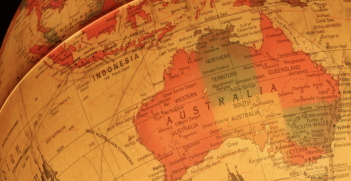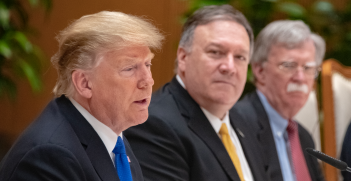70 Years of Australia-US Educational Relations

The focus of Australia-US relations is most often on mutual security and economic ties. But it is also important to acknowledge the significant role that educational linkages and exchanges have played in furthering the bond between the two countries.
In any analysis of Australian foreign policy the United States occupies a prominent place. Be it on occasion of the upcoming elections in Australia or the role of Australia in Asia-Pacific geopolitics, and regardless of the differences or similarities in attitudes about key issues between Australians and Americans, Australia and the United States greatly matter to each other in several ways.
In defence, record of Australian and American troops fighting together goes as far back as the Battle of Hamel in France (1918), decades before the establishment of diplomatic relations between the two countries took place in 1940 and the Australia, New Zealand & United States (ANZUS) Security Treaty was signed in 1951. According to the Department of Foreign Affairs and Trade (DFAT), the ANZUS Treaty is “Australia’s pre-eminent security treaty alliance and enjoys broad bipartisan support.”
As for the economy, the Australia-United States Free Trade Agreement that came into effect in 2005 served to enhance an already robust binational economic relationship. The United States is Australia’s largest investor (ten times greater than China) and its second largest trading partner. At the same time, the United States is the single largest destination of outbound Australian investment, with over a quarter of all Australian overseas investment going to the United States (more than seven times the amount going to China).
However, the first treaty signed between the two countries was an “Agreement between the Government of Australia and the Government of the United States of America for the Use of Funds made available in accordance with the Agreement on Settlement of Lend-Lease, Reciprocal Aid, Surplus War Property and Claims of 7 June 1946,” (also known as the “Fulbright Agreement”) which entered into force on the 26 November 1949. Thanks to this agreement, more than 5,100 Australians and Americans have received scholarships to undertake academic degrees or research visits in the other’s country since 1950. According to DFAT, approximately 11,000 Americans were studying at Australian education institutions in 2017, with 2,500 Australians pursuing full-time academic studies in the United States at approximately the same time. Data from the Institute of international Education indicate that the number of Americans studying in Australia in 2018 was 9,112, while that of Australians studying in the United States in 2016 was 5,061.
Among other icons of the educational partnership between the United States and Australia are: the Australian-American Fulbright Commission (formerly the “Australian-American Educational Foundation” and originally the “United States Educational Foundation in Australia”); the United States Study Centre, opened in 2007 at the University of Sydney with a AU $25 million endowment and the Perth USAsia Centre, opened at the University of Western Australia in 2012, with the Australian government announcing an additional AU $12 million for these centres in 2018; the American Australian Association, the Australian American Association; and the Australian American Leadership Dialogue.
Numbers are important, but the quality of the educational exchanges is highly relevant too, especially in terms of the transformational impact these exchanges have not only on the individuals undertaking them but also for their countries of origin and adoption. Among many possible examples, two clearly illustrate this point.
Jill Ker Conway was born in New South Wales in 1934 and completed a history degree at the University of Sydney in 1958. A Fulbright scholarship allowed her to move to the United States in 1960, where she earned a PhD at Harvard in 1969. After her marriage to John Conway, they both accepted teaching positions in Canada. Jill eventually became a dean (1970) and then the first female vice president of the University of Toronto (1973), and president of Smith College in Massachusetts (1975). She authored bestselling memoirs The Road from Coorain, True North and A Woman’s Education. In 2013 she was both awarded the National Humanities Medal by President Obama and appointed an Honorary Companion of the Order of Australia by the Australian Government for “eminent service to the community, particularly women, as an author, academic and through leadership roles with corporations, foundations, universities and philanthropic groups.” Conway died in Boston last in 2018.
Brian Schmidt was born in Montana in 1967. He received undergraduate degrees in Astronomy and Physics from the University of Arizona in 1989, and earned an Astronomy Master’s degree (1992) and a PhD (1993) from Harvard University. A Fellow of the Australian Academy of Science, The United States Academy of Science, and the Royal Society, he was made a Companion of the Order of Australia in 2013. In 2011 he was awarded (together with three other researchers) the Nobel Prize in Physics “for the discovery of the accelerating expansion of the Universe through observations of distant supernovae.” Schmidt is currently the vice-chancellor, president and chief executive officer of the Australian National University, and continues his academic activity there as a distinguished professor of astronomy.
Australian-American defence and economic relations are evidently as significant in the life of both countries today as they were in the twentieth century. But the importance of their academic, research and cultural exchanges, as attested in the stories of thousands of Australians and Americans on both sides of the Pacific to this day, should not be overlooked. It is these interactions that provide the best hope for a constructive and fruitful relationship between our two countries in the twentieth-first century.
Dr Pablo Cristóbal Jiménez Lobeira is the alumni relations manager at the Australian-American Fulbright Commission and an adjunct lecturer at the Institute for Ethics and Society at the University of Notre Dame Australia. He has sixteen years of experience in international education, six of them at Fulbright.
This article is published under a Creative Commons License and may be republished with attribution.




